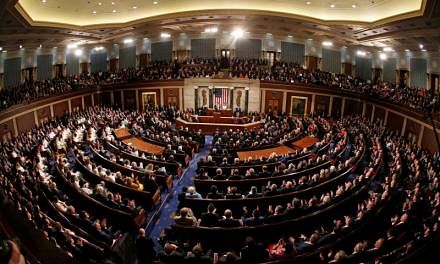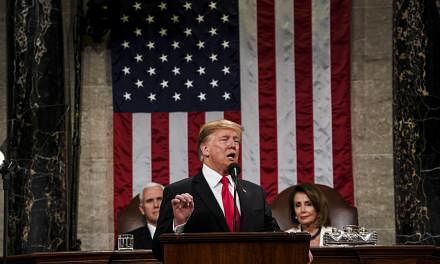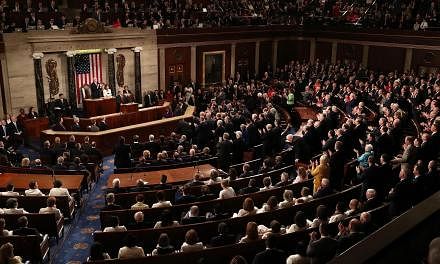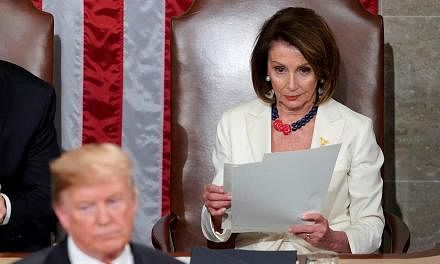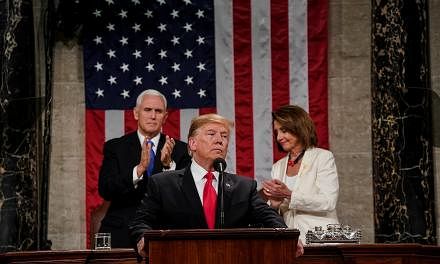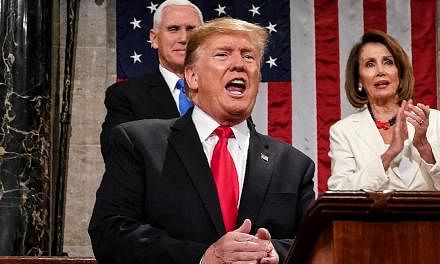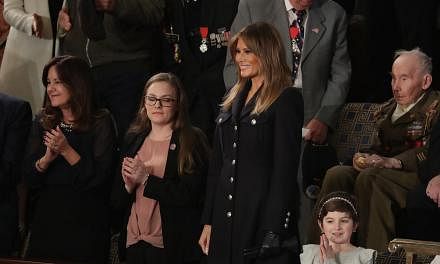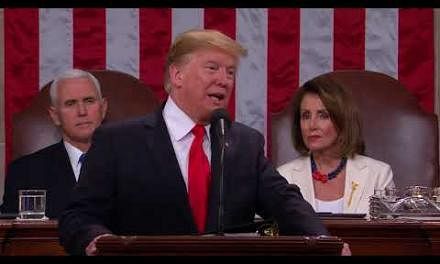WASHINGTON (WASHINGTON POST) - US President Donald Trump delivered his second State of the Union address in a divided Washington Tuesday (Feb 5) night.
Here are five takeaways:
1. A DISCORDANT CALL FOR UNITY
From the start, it was clear Trump wanted his speech to be remembered as a call for bipartisanship, a high-minded missive about common ground.
"We must reject the politics of revenge, resistance, and retribution - and embrace the boundless potential of cooperation, compromise, and the common good," Trump said.
"Together, we can break decades of political stalemate. We can bridge old divisions, heal old wounds, build new coalitions, forge new solutions and unlock the extraordinary promise of America's future. The decision is ours to make. We must choose between greatness or gridlock, results or resistance, vision or vengeance, incredible progress or pointless destruction."
This language completely glosses over the last three-and-a-half years.
Whatever you think of Trump's politics, he has pursued a divisive political strategy very much focused on his base.
Many of the "divisions" and "wounds" predated him, yes, but he has exacerbated them with an unyielding, uncompromising and controversial style that relies on fomenting culture wars and humiliating those who run afoul of him.
Democrats will see this as a thoroughly convenient evolution, now that they control the House and Trump needs them. And that's if they think he means it at all. Trump has tried this kind of language before, and he's never maintained the posture for long.
2. A CALL FOR A WALL, BUT NO DEMAND
The unity-and-bipartisanship call was always going to be a difficult circle to square given the events of the past month and a half.
The 35-day shutdown that Trump forced for border-wall funding is over, but the issue is not settled, and the two sides appear as entrenched as ever ahead of their Feb 15 deadline.
A big question going into Tuesday was how much Trump would press for the wall. He did, but only kind of.
While Trump emphasised the wall in a substantial section of the speech, he didn't talk about it in terms of an ultimatum. Instead, he pitched it as something that he wanted.
"In the past, most of the people in this room voted for a wall - but the proper wall never got built," Trump said. "I'll get it built." Trump added: "It will be deployed in the areas identified by border agents as having the greatest need, and as these agents will tell you, where walls go up, illegal crossings go way down."
As a candidate, Trump promised a wall along the whole border. In recent weeks, he has said Democrats must agree to it. He said neither on Tuesday. Nor did he address whether he'll declare a national emergency to try and build it, which is controversial even among Republicans.
3. A DOUBLE-DOWN ON WITHDRAWAL FROM AFGHANISTAN AND SYRIA
Trump's planned withdrawals from both Afghanistan and Syria are in something of a state of flux, in large part because of concerns among military brass and Republicans about pulling out too quickly and leaving a vacuum. The Senate even voted to rebuke Trump.
In his speech, Trump provided a couple brief nods to his previously expressed intentions. "As a candidate for president, I pledged a new approach," he said. "Great nations do not fight endless wars."
He added: "Now, as we work with our allies to destroy the remnants of ISIS, it is time to give our brave warriors in Syria a warm welcome home."
This isn't the same as Trump saying, "We're withdrawing by such-and-such date," and as with many of Trump's expressed plans, it's subject to change. But he decided to include this in this most important of speeches for a reason. So consider it a mark of his intentions.
4. AREAS FOR COMPROMISE?
While bipartisanship will be a tough sell over the next two years, given the last two years and the 2020 presidential campaign already getting off the ground, Trump did highlight two areas where logic suggest it's at least possible: Infrastructure and drug prices.
"Both parties should be able to unite for a great rebuilding of America's crumbling infrastructure," Trump said, rekindling a long-promised effort that thus far hadn't been prioritised by the GOP-controlled Congress of the past two years.
He added of prescription drugs: "It is unacceptable that Americans pay vastly more than people in other countries for the exact same drugs, often made in the exact same place," Trump said. "This is wrong, unfair, and together we can stop it."
Trump has hit on these themes before, including during the 2016 campaign. Whether the two sides take either of them up will tell us whether there's any hope for truly bipartisan legislation in 2019. They are the starting points if he meant much of what he said Tuesday.
5. THE WOMEN'S WHITE-OUT - AND A BIPARTISAN CELEBRATION
Many of the female members of Congress, including House Speaker Nancy Pelosi (Democrat, California) opted to wear white. It was a show of party and female unity, and it was also visually arresting, reinforcing the chasm between the two parties when it comes to gender diversity.
Trump, though, met the moment with his prepared speech.
Perhaps the most bipartisan and raucous moment of the night came when he saluted the record number of women in the new Congress.
"All Americans can be proud that we have more women in the workforce than ever before," he said, beginning to draw an almost surprised, positive reaction from Democrats, "and exactly one century after the Congress passed the Constitutional amendment giving women the right to vote, we also have more women serving in the Congress than ever before."

